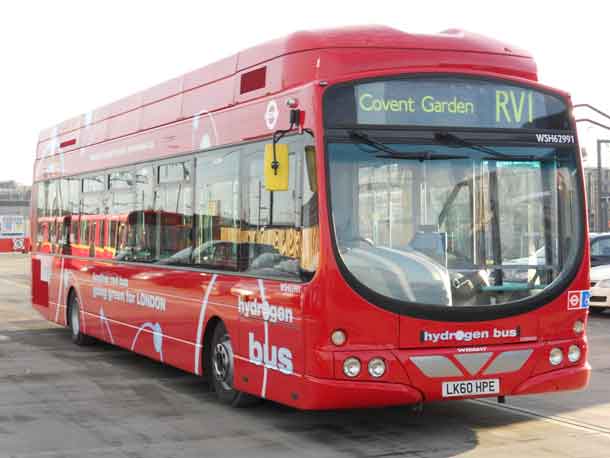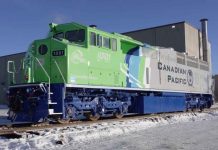 By Stan Thompson
By Stan ThompsonMooresville, NC, USA – 23 March, 2018 — Chaos theory tells us that the flapping of a butterfly’s wings in the South Pacific could conceivably spark a hurricane in the Atlantic but the intervening steps would never be known. Ontarians have sparked one of the major climate change mitigation processes working on the globe today. I’ve had the good fortune to watch their progress and see the intervening steps, domino by domino. Since about 1998, the Province has made a profound contribution in moving the world toward a post-carbon energy economy in the railway domain.
A domino chain is an imperfect metaphor, though. A better analogy might be the confluence of streams to form a river because so many Ontarians have swelled the hydrail flow.
But, just as a river has one understood headwater source, one ON contribution stands out. Around 1999 Dr. Alistair Miller at the—then—Atomic Energy of Canada Labs in Chalk River (now Canadian Nuclear Laboratories) wrote a paper showing that rail and marine applications were the most practical way to introduce hydrogen as a transportation energy carrier. Rail and marine lacked the myriad of retail complications that have stymied hydrogen cars until recently.
In North Carolina, Dr. Robert Johnson—Dean of Engineering at the University of North Carolina at Charlotte—found Dr. Miller’s paper online and passed it to the Mooresville South Iredell [County, NC] Chamber of Commerce, where, in 2005, the first US effort to introduce fuel cell transit was just taking off. That effort came to be called The Mooresville Hydrail Initiative.
In Charlotte, several months after receiving Dr. Miller’s paper, the Mooresville Chamber and Appalachian State University in Boone, NC, convened the first of twelve (so far) International Hydrail Conferences. Ontarian Dr. Alistair Miller was a presenter at that first “IHC”—a role he was to reprise several times.
The following year, 2006—in Herning, Denmark, at the Second International Hydrail Conference—train manufacturer Alstom Transport of Paris proposed the first commercial hydrail design. The main purpose of the design was to rid Bordeaux and other scenic cities of the unsightly tangle of overhead wires needed by nineteenth-century overhead transit electrification.
Year after year, International Hydrail Conferences were held in Spain, Turkey, the UK and the USA until 2013. That was the pivotal year when Ontarian energy expert Robert Stasko organized the Eighth International Hydrail Conference at Ryerson University in Toronto.
The Toronto IHC marked the transition of the Mooresville Hydrail Initiative from an expert forum about what should be done and why, to a commercial vision of what would be done and how.
In Toronto, Dr. CHEN Weirong of China’s Southwest Jiaotong [railway engineering] University described China’s first hydrail locomotive, the Blue Sky. Later that year, as a consequence of the Toronto conference, Mooresville presented its vision of the future of passenger hydrail in Shanghai. Two years later China opened two hydrail tram plants—in Qingdao and Tangshan—where Chinese rolling stock powered by Canadian fuel cells is being produced today. Southwest Jiaotong U. partnered with China Railway Rolling Stock Corporation to introduce these wireless electric trams.
Also at the 2013 Toronto Conference were two prominent Ontarian keynote presenters; the Honorable Glen Murray, ON Minister of Transportation and Infrastructure and, from Mississauga, Hydrogenics Corporation’s CEO, Daryl Wilson.
In the audience was an Ontarian associate of Alstom Transport, who passed Daryl Wilson’s vision back to Paris. The rest is history: after about two years of quiet behind-the-scenes discussions, the 24 September 2014 issue of Railway Gazette announced “Fuel cells to power regional trainsets” in Germany.
Also presenting at the International Hydrail Conference in 2013 was Herr Detlef Matthiessen, leader of the Green Party delegation in the Schleswig-Holstein and Dr. Holger Busche, who—in 1998—was the first person anywhere to propose that passenger trains could be powered by hydrogen electrolyzed from wind turbine energy.
The following year, 2014, in Neumünster, Germany, Schleswig-Holstein hosted the Ninth International Hydrail Conference. The presenter list included Stefan Kaimer of the German Aerospace Center. The Schleswig-Holstein Parliament has now committed to replacing all carbon-fueled railway vehicles in the State with hydrail by 2025—just seven years from now. The 2013 Toronto International Hydrail Conference almost certainly played the decisive role in Schleswig-Holstein, Germany’s pioneering decision.
Not long after the Hydrail Conference in Neumünster, Germany’s Federal Government commissioned a look at hydrail at the national level. Commenting on the study results, Transport Ministry State Secretary Rainer Bomba said, “…electric railcars can be a low emission alternative to diesel operations. We want to support this development. For this reason, we have made rail transportation a focus of funding in our National Innovation Programme.”
Last year, inspired by Germany’s enthusiasm, Ontario took hydrail technology to the next level—literally. The future of bi-level Metrolinx trains may well be hydrail. If so, this represents much larger hydrail passenger vehicles than any built before.
Early in this century, Ontario played a crucial role in the launching of the Mooresville/Appalachian State University International Hydrail Conferences. The Toronto International Hydrail Conference in 2013 was the tipping point that moved hydrail from the theoretical to the commercial phase. Ontarian Robert Stasko organized that pivotal event. Aside from its profound and historic results, attendance—roughly 200—was more than twice as many as any IHC before or since.
It’s only fitting that I acknowledge with gratitude the encouragement that the Mooresville Hydrail Initiative has received from Thunder Bay and the NetNewsLedger over the years.
Over ten years ago, the Paris-based
Union Internationale des Chemins de Fer (International Union of Railways) held a series of “Hyrail” meetings in Europe. Several of us involved felt that Bombardier in hydrogen-savvy Ontario would be an ideal pioneer for hydrail commercialization. When Premier McGuinty echoed our thinking, we were excited and pulling for Thunder Bay to lead the hydrail revolution. When it fell through, Mooresville shared Thunder Bay’s disappointment.
Today, China Railway Rolling stock Corporation has two producing hydrail plants; Siemens and Alstom are combining forces, the better to compete. The world hydrail transition has clearly begun and is now, I’m certain, irreversible.
Since 2003, I have been sure that oil economics, pollution, climate change risk and the exorbitant antiquity that is overhead electrification will all demand a world-wide transition to hydrail. It never occurred to me, though, that an anti-technology bias in the general media would be able to block the inevitable for a decade or more, despite these practical considerations.
Fortunately, the Internet lets online publications like The NetNewsLedger punch significant holes in “the newsprint curtain.”
Someday the sunlight that peeks through these holes may call the world hydrail transition to the attention of the Wall Street Journal or the Toronto Star. Until then, Mooresville and Thunder Bay will just keep taking turns, tapping the world on the shoulder and pointing the the hydrail future.
Stan Thompson
The Mooresville Hydrail Initiative
Thirteenth International Hydrail Conference
University of Rome, Tor Vergata—June 6,7,8, 2018




